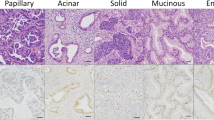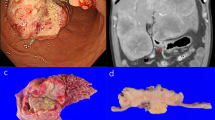Abstract
Background
Esophageal squamous cell carcinoma (ESCC) is a lethal malignancy, but only limited molecular markers can predict its prognosis. Recently, a DNA double-strand break repair protein Nijmegen breakage syndrome 1 (NBS1) was reported to induce Snail expression and predict poor prognosis in head and neck cancers. However, the clinicopathologic roles of NBS1 and Snail in ESCC remain unclear.
Methods
From January 1995 to September 1999, tissue samples from 153 patients with ESCC who underwent esophagectomies at our institutions were collected and made into tissue core arrays for study. Expression of NBS1 and Snail was examined by immunohistochemical staining. The clinicopathologic data were analyzed, and some additional studies were performed to explore the relationship between NBS1 and Snail.
Results
NBS1 overexpression was observed in 28.1% (43/153) of ESCC, whereas Snail overexpression was observed in 26.1% (40/153) of ESCC. Overexpression of NBS1 correlated inversely with nodal status (P = 0.009) and was associated with better overall survival (P = 0.002). On the other hand, overexpression of Snail correlated positively with lymphovascular invasion (P = 0.034) and was associated with worse overall survival (P = 0.036). Meanwhile, NBS1 overexpression correlated inversely with Snail overexpression marginally (P = 0.084). Using the Cox regression analysis, T status (P = 0.006), M status (P = 0.008), and NBS1 overexpression (P = 0.007) were the independent factors of overall survival.
Conclusions
Our results showed that NBS1 overexpression was an independent factor of better survival and Snail overexpression predicted a worse survival in ESCC. Combination of NBS1 plus Snail expression status could be used as a predictor of prognosis in ESCC.




Similar content being viewed by others
References
Department of Health, the Executive Yuan, Republic of China. Statistics of Causes of Death and Cancer Registry Annual Report in Taiwan area, 2010.
Law S, Kwong DL, Kwok KF, et al. Improvement in treatment results and long-term survival of patients with esophageal cancer: impact of chemoradiation and change in treatment strategy. Ann Surg. 2003;238:339–47.
Berger AC, Farma J, Scott WJ, et al. Complete response to neoadjuvant chemoradiotherapy in esophageal carcinoma is associated with significantly improved survival. J Clin Oncol. 2005;23:4330–7.
Jemal A, Siegel R, Xu J, Ward E. Cancer statistics, 2010. CA Cancer J Clin. 2010;60:277–300.
Chrzanowska KH, Kleijer WJ, Krajewska-Walasek M, et al. Eleven Polish patients with microcephaly, immunodeficiency, and chromosomal instability: the Nijmegen breakage syndrome. Am J Med Genet. 1995;57:462–71.
van der Burgt I, Chrzanowska KH, Smeets D, Weemaes C. Nijmegen breakage syndrome. J Med Genet. 1996;33:153–6.
Varon R, Vissinga C, Platzer M, et al. Nibrin, a novel DNA double-strand break repair protein, is mutated in Nijmegen breakage syndrome. Cell. 1998;93:467–76.
D’Amours D, Jackson SP. The Mre11 complex: at the crossroads of DNA repair and checkpoint signaling. Nat Rev Mol Cell Biol. 2002;3:317–27.
Chiang YC, Teng SC, Su YN, et al. c-Myc directly regulates the transcription of the NBS1 gene involved in DNA double-strand break repair. J Biol Chem. 2003;278:19286–91.
Chen YC, Su YN, Chou PC, et al. Overexpression of NBS1 contributes to transformation through the activation of phosphatidylinositol 3-kinase/Akt. J Biol Chem. 2005;280:32505–11.
Yang MH, Chiang WC, Chou TY, et al. Increased NBS1 expression is a marker of aggressive head and neck cancer and overexpression of NBS1 contributes to transformation. Clin Cancer Res. 2006;12:507–15.
Yang MH, Chang SY, Chiou SH, et al. Overexpression of NBS1 induces epithelial-mesenchymal transition and co-expression of NBS1 and Snail predicts metastasis of head and neck cancer. Oncogene. 2007;26:1459–67.
Gupta GP, Massagué J. Cancer metastasis: building a framework. Cell 2006;127:679–95.
Thiery JP. Epithelial-mesenchymal transitions in tumour progression. Nat Rev Cancer. 2002;2:442–54.
Batlle E, Sancho E, Francí C, et al. The transcription factor snail is a repressor of E-cadherin gene expression in epithelial tumour cells. Nat Cell Biol. 2000;2:84–9.
Ohkubo T, Ozawa M. The transcription factor Snail downregulates the tight junction components independently of E-cadherin downregulation. J Cell Sci. 2004;117:1675–85.
Cano A, Perez-Moreno MA, Rodrigo I, et al. The transcription factor snail controls epithelial-mesenchymal transitions by repressing E-cadherin expression. Nat Cell Biol. 2000;2:76–83.
Martin TA, Goyal A, Watkins G, Jiang WG. Expression of the transcription factors snail, slug, and twist and their clinical significance in human breast cancer. Ann Surg Oncol. 2005;12:488–96.
Elloul S, Elstrand MB, Nesland JM, et al. Snail, Slug, and Smad-interacting protein 1 as novel parameters of disease aggressiveness in metastatic ovarian and breast carcinoma. Cancer. 2005;103:1631–43.
Miyoshi A, Kitajima Y, Kido S, et al. Snail accelerates cancer invasion by upregulating MMP expression and is associated with poor prognosis of hepatocellular carcinoma. Br J Cancer. 2005;92:252–8.
Natsugoe S, Uchikado Y, Okumura H, et al. Snail plays a key role in E-cadherin-preserved esophageal squamous cell carcinoma. Oncol Rep. 2007;17:517–23.
Kuo KT, Wang HW, Chou TY, et al. Prognostic Role of PGE2 Receptor EP2 in Esophageal Squamous Cell Carcinoma. Ann Surg Oncol. 2009;16:352–60.
Wang LS, Chow KC, Wu CW. Expression and up-regulation of interleukin-6 in oesophageal carcinoma cells by n-sodium butyrate. Br J Cancer. 1999;80:1617–22.
Hung JJ, Yang MH, Hsu HS, Hsu WH, Liu JS, Wu KJ. Prognostic significance of hypoxia-inducible factor-1α, TWIST1 and Snail expression in resectable non-small cell lung cancer. Thorax. 2009;64:1082–9.
David O, Jett J, LeBeau H, et al. Phospho-Akt overexpression in non-small cell lung cancer confers significant stage-independent survival disadvantage. Clin Cancer Res. 2004;10:6865–71.
Uchikado Y, Natsugoe S, Okumura H, et al. Slug Expression in the E-cadherin preserved tumors is related to prognosis in patients with esophageal squamous cell carcinoma. Clin Cancer Res. 2005;11:1174–80.
Wang YF, Chow KC, Chang SY, Chiu JH, Tai SK, Li WY, Wang LS. Prognostic significance of nm23-H1 expression in oral squamous cell carcinoma. Br J Cancer. 2004;90:2186–93.
Hsu DS, Chang SY, Liu CJ, et al. Identification of increased NBS1 expression as a prognostic marker of squamous cell carcinoma of the oral cavity. Cancer Sci. 2010;101:1029–37.
Ehlers JP, Harbour JW. NBS1 expression as a prognostic marker in uveal melanoma. Clin Cancer Res. 2005;11:1849–53.
Gao J, Zhang H, Arbman G, Sun XF. RAD50/MRE11/NBS1 proteins in relation to tumour development and prognosis in patients with microsatellite stable colorectal cancer. Histol Histopathol. 2008;23:1495–502.
Söderlund K, Stål O, Skoog L, Rutqvist LE, Nordenskjöld B, Askmalm MS. Intact Mre11/Rad50/Nbs1 complex predicts good response to radiotherapy in early breast cancer. Int J Radiat Oncol Biol Phys. 2007;68:50–8.
Acknowledgment
This study was supported by grants from National Science Council (NSC95-2314-B-303-023) and Tzu Chi Foundation Medicine Mission (TCRD-I9603-03). The authors also thank Professor Kou-Juey Wu and Professor Muh-Hwa Yang in National Yang-Ming University for their expert opinions on initial preparation of this study and Dr. Hao-Wei Wang at Cornell University for his critical review of the manuscript.
Author information
Authors and Affiliations
Corresponding author
Rights and permissions
About this article
Cite this article
Kuo, KT., Chou, TY., Hsu, HS. et al. Prognostic Significance of NBS1 and Snail Expression in Esophageal Squamous Cell Carcinoma. Ann Surg Oncol 19 (Suppl 3), 549–557 (2012). https://doi.org/10.1245/s10434-011-2043-2
Received:
Published:
Issue Date:
DOI: https://doi.org/10.1245/s10434-011-2043-2




